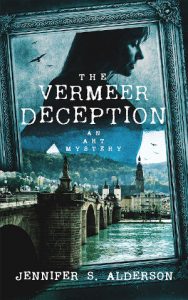Researching Settings from the Comfort of Your Home
By Jennifer S. Alderson
 A well-described setting can elevate your novel and help transport the reader into the story. Incorporating the sights, sounds, smells, and tastes one would experience in a specific place is easier than you may think, even if you can’t travel to the settings you want to describe. Because let’s face it, travel is expensive and not every author has the time or means to visit every place they want to mention in their novel. And in light of the current corona virus crisis and worldwide travel bans, visiting a specific location may not be possible.
A well-described setting can elevate your novel and help transport the reader into the story. Incorporating the sights, sounds, smells, and tastes one would experience in a specific place is easier than you may think, even if you can’t travel to the settings you want to describe. Because let’s face it, travel is expensive and not every author has the time or means to visit every place they want to mention in their novel. And in light of the current corona virus crisis and worldwide travel bans, visiting a specific location may not be possible.
The internet, bookstores, your local library, and television shows offer many viable alternatives. Here are a few of my favorites:
Google Earth and Street View
Nothing beats walking the streets, but Google Earth and Google Street View are a wonderful second best. There are limitations as to where you can visit. For instance one of my novels takes place in Papua, a region Google Earth has not yet mapped. But if you are looking for a bistro in New York or a public park in Atlanta, Google Earth is an excellent resource. Be sure and click on the satellite view once you’ve chosen a general area to explore. In more urban areas, you can usually ‘walk’ down the streets and even pop into shops when using the 3D view.
Travel blogs and travel documentaries
Travel blogs are an excellent way of getting a taste of a specific country, region, or city, from the perspective of someone who has actually visited the locations mentioned. They often provide detailed information and many photographs of local food, transportation, road conditions, clothing styles, and popular tourist attractions.
Travel bloggers usually make a point of describing the tastes, smells, wildlife, and landscapes they encounter along the way. Working these kinds of details into your novel is a great way of adding authenticity and helping to place your characters within the setting.
Their greatest limitation is that they are usually written by tourists and not locals, meaning the blogger may not have much insight into the cultural, historical, or political background of the events or customs they are writing about. In general though, blogs are a great way of getting a feel for a place.
Travel documentaries and shows about travel often showcase the more unusual festivals and customs their camera crews encounter. They are a great way to see how traditional clothes are worn and dances are executed, or what the music sounds like. Yet like blogs, they only show the viewer a small slice of life.
Travelogues, memoirs, and travel fiction
Reading travelogues, memoirs, and travel fiction is another great way of learning more about a country or region. They usually offer more in-depth information about the daily life and local customs than a blogger or television show can. Again, these are usually subject views of a country or place, one heavily influenced by the writer’s personal experiences and background.
Travel Guides
For a more objective look at a country or culture, I suggest reading travel guides. Though many are published by western companies, much of the information included in these guides about the history of a land or their customs is written by a local source. Most strive to be factual and provide general information about customs, language, frequently used phrases, pronunciation, transportation routes, visas, the geography, and the weather.
Travel magazines, documentaries, and non-fiction books
Non-fiction literature, translated fiction, and in-depth articles published in travel and scientific magazines (such as National Geographic and NG Travel) are invaluable resources. They typically provide in-depth, factual information about a specific region of the world and are usually written by either locals, or journalists who have spent weeks in one location interviewing local residents.
I hope these tips give you an idea of where to start learning more about your chosen setting and infusing your fiction with a stronger sense of place.
What is your favorite way of researching the setting of your novel?
—
Jennifer S. Alderson was born in San Francisco, raised in Seattle, and currently lives in Amsterdam. Her love of travel, art, and culture inspires her award-winning mystery series—the Zelda Richardson Mysteries and Travel Can Be Murder Cozy Mysteries—and standalone stories.
After traveling extensively around Asia, Oceania, and Central America, she moved to Darwin, Australia, before settling in the Netherlands. Her background in journalism, multimedia development, and art history enriches her novels. When not writing, she can be found in a museum, biking around Amsterdam, or enjoying a coffee along the canal while planning her next research trip.
Website: http://www.jennifersalderson.com
Facebook: http://www.facebook.com/jenniferSAldersonauthor
Twitter: http://www.twitter.com/JSAauthor
Goodreads: https://www.goodreads.com/JennifeSAlderson
BookBub: https://www.bookbub.com/authors/jennifer-s-alderson
Amazon Author Page: https://www.amazon.com/Jennifer-S.-Alderson/e/B019H079RA/
The Vermeer Deception: An Art Mystery
 An art historian finds – then loses – a portrait by Johannes Vermeer in this thrilling art mystery set in Munich, Heidelberg, and Amsterdam.
An art historian finds – then loses – a portrait by Johannes Vermeer in this thrilling art mystery set in Munich, Heidelberg, and Amsterdam.
When Zelda Richardson investigates a new lead about a missing portrait by Johannes Vermeer, no one expects her to actually find the painting in a retired art dealer’s home in Munich, Germany. Not her parents visiting from America; her boss, private detective Vincent de Graaf; or the rightful owner of the Nazi-looted artwork.
However, Zelda’s jubilation turns to horror when she arrives to pick up the portrait and finds the art dealer dead and several frames smoldering in his fireplace.
Was the Vermeer a fake and its ‘discovery’ a cruel joke played on a Nazi victim? The Munich police, Zelda’s family, and Vincent certainly think so.
Yet the art dealer’s best friend believes he was murdered and the real Vermeer stolen by an underground network of art looters, one established during World War II and still active today. The problem is, no one believes him – except Zelda.
Zelda soon finds herself in a dangerous game of cat-and-mouse with immoral art collectors, corrupt dealers, and an all-to-real killer who wants her to stop searching.
Can Zelda uncover the truth about the Vermeer before she is painted out of the picture permanently?
The Vermeer Deception is Book 4 in the Zelda Richardson Mystery Series. The novels in this series can be read in any order.
Available at Amazon on April 4, 2020. http://getbook.at/TheVermeerDeception
Category: How To and Tips

























It’s very interesting to see how different authors research location!
Thank you so much for featuring this article on your website! I hope everyone stays healthy and safe during this crazy and turbulent time.